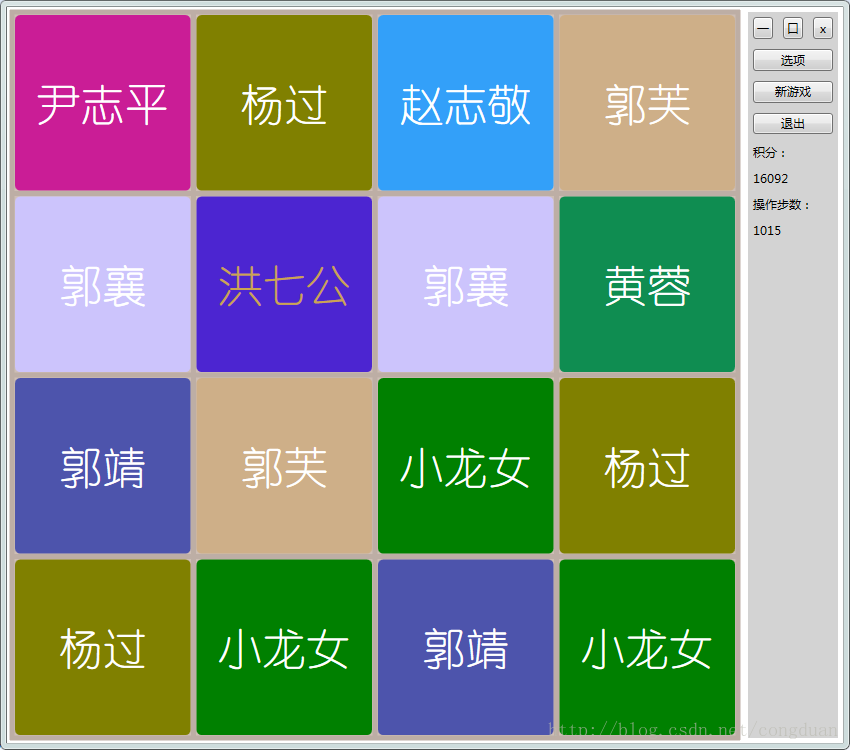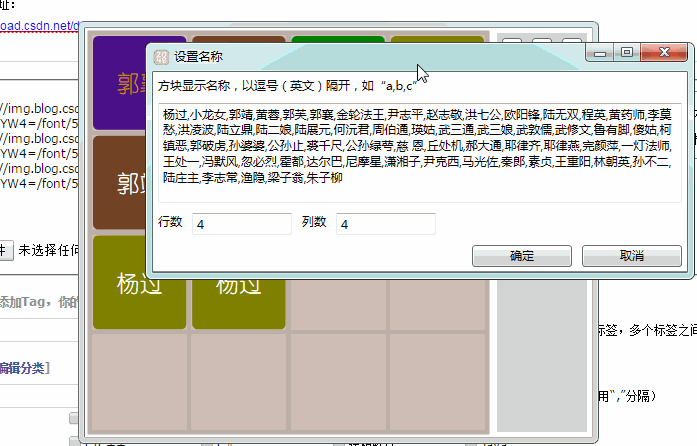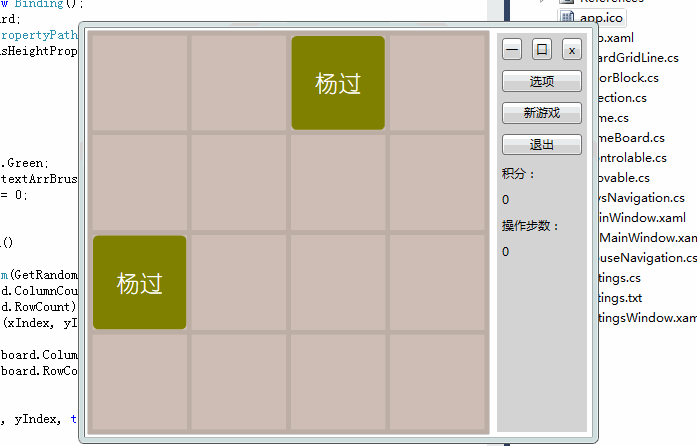WPF实现2048小游戏
前几天空闲的时候,实现了一个2048游戏。除了可以设置行数和列数之外,支持修改显示名称,比如下面,改成神雕侠侣中的角色名称:

游戏逻辑比较简单,大家都应该玩过。
这里主要实现了四个类:Game、GameBoard还有ColorBlock和BoardGridLine。
Game类主要用来实现游戏的控制,比如初始化、添加新的色块、移除色块、控制色块上下左右移动、改变积分,触发游戏结束等。
GameBoard继承自Canvas,实现了色块的合并、检测每个格子的状态等,另外提供了Game控制色块移动的接口。
ColorBlock类继承自Shape类,用于自定义色块的显示,包含XY坐标、颜色、显示文字等依赖属性,可以进行动画,另外还实现了具体的上下左右移动的方法。最初几个颜色是手动设置,等到色块越来越多,就随机生成一种颜色。
BoardGridLine也继承自Shape类,用于绘制Canvas底部的网格。
另外,游戏使用一个简单的文本文件保存设置,包括行数与列数,以及显示文字及其对应颜色,具体操作在Settings类中。
最后,按键事件封装在KeysNavigation中。
图标使用Expression Design制作:

游戏效果如下:


Game.cs
using System;
using System.Collections.Generic;
using System.Linq;
using System.Text;
using System.Windows.Documents;
namespace game2048
{
public class Game
{
public enum State
{
Idel,
Start,
Running,
}
ColorBlock[,] fillState;
private int score = 0;
private int step = 0;
public ColorBlock[,] FillState
{
get
{
return fillState;
}
}
GameBoard board;
public Game(GameBoard board)
{
this.board = board;
fillState = new ColorBlock[board.RowCount, board.ColumnCount];
for (int i = 0; i < board.RowCount; i++)
{
for (int j = 0; j < board.ColumnCount; j++)
{
fillState[i, j] = null;
}
}
}
public void init()
{
Settings.load();
ColorBlock block = new ColorBlock(board);
ColorBlock block1 = new ColorBlock(board);
//FillState[block.XIndex, block.YIndex] = block;
// FillState[block1.XIndex, block1.YIndex] = block1;
//BlockList.Add(block);
//BlockList.Add(block1);
}
public void addNew()
{
if (board.hasNoPlace())
{
gameOver(false);
return;
}
ColorBlock block = new ColorBlock(board);
//FillState[block.XIndex, block.YIndex] = block;
//BlockList.Add(block);
}
public void remove(int xIndex,int yIndex)
{
if (FillState[yIndex, xIndex] != null)
{
board.Children.Remove(FillState[yIndex, xIndex]);
FillState[yIndex, xIndex] = null;
}
}
public void toLeft()
{
bool add = false;
for (int i = 0; i < board.ColumnCount; i++)
{
for (int j = 0; j < board.RowCount; j++)
{
if (FillState[j, i] != null)
{
add |= FillState[j, i].moveLeft();
}
}
}
if (add)
{
addNew();
fireSetpChanged();
}
}
public void toRight()
{
bool add = false;
for (int i = board.ColumnCount-1; i >=0 ; i--)
{
for (int j = 0; j < board.RowCount; j++)
{
if (FillState[j, i] != null)
{
add |= FillState[j, i].moveRight();
}
}
}
if (add)
{
addNew();
fireSetpChanged();
}
}
public void toUp()
{
bool add = false;
for (int i = 0; i < board.ColumnCount; i++)
{
for (int j = 0; j < board.RowCount; j++)
{
if (FillState[j, i] != null)
{
add |= FillState[j, i].moveUp();
}
}
}
if (add)
{
addNew();
fireSetpChanged();
}
}
public void toDown()
{
bool add = false;
for (int i = 0; i < board.ColumnCount; i++)
{
for (int j = board.RowCount-1; j >=0; j--)
{
if (FillState[j, i] != null)
{
add |= FillState[j, i].moveDown();
}
}
}
if (add)
{
addNew();
fireSetpChanged();
}
}
public delegate void onScoreChange(int score);
public event onScoreChange onScoreChangeHandler;
public delegate void onStepChange(int step);
public event onStepChange onStepChangeHandler;
public delegate void onGameOver(bool success);
public event onGameOver onGameOverHandler;
public void fireSetpChanged()
{
step++;
if (onStepChangeHandler != null)
onStepChangeHandler(step);
}
/// <summary>
/// 增加积分
/// </summary>
/// <param name="offset"></param>
public void incScore(int offset)
{
score += offset;
if (onScoreChangeHandler != null)
{
onScoreChangeHandler(score);
}
}
public void gameOver(bool success)
{
if (onGameOverHandler != null)
{
onGameOverHandler(success);
}
}
public void reset()
{
score = 0;
step = 0;
if (onStepChangeHandler != null)
onStepChangeHandler(step);
if (onScoreChangeHandler != null)
onScoreChangeHandler(score);
for (int i = 0; i < board.RowCount; i++)
{
for (int j = 0; j < board.ColumnCount; j++)
{
remove(i, j);
}
}
}
}
}
GameBoard.cs
using System;
using System.Collections.Generic;
using System.Linq;
using System.Text;
using System.Windows.Controls;
using System.Diagnostics;
namespace game2048
{
public class GameBoard : Canvas, IControlable
{
private int rowCount = 4;
public int RowCount
{
get
{
return rowCount;
}
set
{
rowCount = value;
}
}
private int columnCount = 4;
public int ColumnCount
{
get
{
return columnCount;
}
set
{
columnCount = value;
}
}
Game game = null;
public GameBoard()
{
this.Focusable = true;
this.Focus();
this.reset();
}
public void reset()
{
Settings.load();
RowCount = Settings.rowCount;
ColumnCount = Settings.columnCount;
}
public void init(Game game)
{
this.game = game;
game.init();
}
public void toLeft()
{
game.toLeft();
Debug.WriteLine("Left");
}
public void toRight()
{
game.toRight();
Debug.WriteLine("Right");
}
public void toUp()
{
game.toUp();
Debug.WriteLine("Up");
}
public void toDown()
{
game.toDown();
Debug.WriteLine("Down");
}
//合并,是否继续
public bool union(int xIndex, int yIndex, Direction dirct)
{
switch (dirct)
{
case Direction.Left:
game.remove(xIndex - 1, yIndex);
break;
case Direction.Right:
game.remove(xIndex + 1, yIndex);
break;
case Direction.Up:
game.remove(xIndex, yIndex - 1);
break;
case Direction.Down:
game.remove(xIndex, yIndex + 1);
break;
default:
break;
}
bool ret = game.FillState[yIndex, xIndex].changeText();
if (ret)
{
game.gameOver(true);
return false;
}
game.incScore(game.FillState[yIndex, xIndex].TextIndex);
return true;
}
public int getState(int xIndex, int yIndex)
{
if (xIndex < 0 || xIndex > columnCount - 1)
return 0;
if (yIndex < 0 || yIndex > rowCount - 1)
return 0;
if (game.FillState[yIndex,xIndex] == null)
return 0;
return game.FillState[yIndex, xIndex].TextIndex;
}
public bool hasNoPlace()
{
return this.Children.Count == this.RowCount * this.ColumnCount+1;
}
public bool isLocationFilled(int xIndex,int yIndex)
{
if (xIndex < 0 || xIndex > columnCount-1)
return true;
if (yIndex < 0 || yIndex > rowCount-1)
return true;
if (game.FillState[yIndex, xIndex] == null)
return false;
return game.FillState[yIndex, xIndex].TextIndex>0;
}
public void setState(int xIndex,int yIndex,ColorBlock block)
{
game.FillState[yIndex, xIndex] = block;
}
}
}
源码下载地址:2048小游戏
以上就是本文的全部内容,希望对大家的学习有所帮助,也希望大家多多支持我们。
赞 (0)

